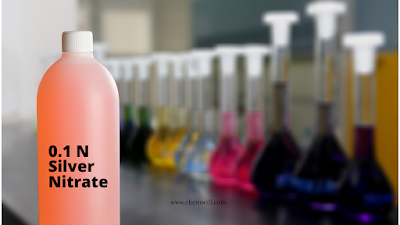0.1 N Silver Nitrate Solution
Preparation of 0.1 N Silver Nitrate Solution
- Dry 17.5 g of silver nitrate (AgNO3) at 105°C for 1 h. Cool in a desiccator.
- Transfer 16.99 g of the dried AgNO3 to a 1-L volumetric flask.
- Add 500 ml of water, swirl to dissolve the AgNO3, dilute to the mark with water, and mix. Store the solution in a tightly stoppered amber-glass bottle.
NOTE —If desired the solution may also be prepared on a determinate basis by weighing the dried silver nitrate accurately and diluting the solution carefully to volume.
Standardization of 0.1 N Silver Nitrate Solution
Warning—Nitrobenzene, used in this section, is extremely hazardous when absorbed through the skin or when its vapor is inhaled. Such exposure may cause cyanosis; pro-
longed exposure may cause anemia. Do not get in eyes, on skin, or on clothing. Avoid breathing vapor. Use only with adequate ventilation.
longed exposure may cause anemia. Do not get in eyes, on skin, or on clothing. Avoid breathing vapor. Use only with adequate ventilation.
- Dry 0.3 g of sodium chloride (NaCl) at 105°C for 2 h. Cool in a desiccator.
- Weigh accurately 0.28 ± 0.01 g of the dried NaCl and transfer to a 250-mL glass-stoppered conical
flask. - Add 25 mL of water, swirl to dissolve the NaCl, and
- Add
2 mL of nitric acid (HNO3). Add from a volumetric pipet, 50
mL of the AgNO3 solution, while mixing thoroughly, - Add 1 mL
of ferric ammonium sulfate solution (FeNH 4(SO4)2·12H2O, 80
g/L) and 5 mL of nitrobenzene (Warning, see). - Stopper
the flask and shake vigorously to coagulate the precipitate.
Rinse the stopper into the flask with a few milliliters of water
and titrate the excess of AgNO3 with ammonium thiocyanate
solution (NH4SCN) until the first permanent reddish-brown
color appears and persists after vigorous shaking for 1 min. - Preparation of ammonium thiocyanate. Solution does
not need to be standardized for use here. (See Note ) - Designate the volume of NH4SCN solution required for the
titration as Volume I. - Using the same volumetric pipet used in , transfer
50 mL of the AgNO3 solution to a clean, dry, 250-mL,
glass-stoppered conical flask. - Add 25 mL of water, 2 mL of
HNO3, 1 mL of FeNH4(SO4)2·12H2O solution, stopper the
flask, and shake vigorously. - Rinse the stopper into the flask
with a few milliliters of water and titrate the AgNO3 solution
with NH4SCN solution until the first permanent reddish-brown
color appears and persists after vigorous shaking for 1 min. - Designate the volume of NH4SCN solution consumed as
Volume II. - Measure accurately, from either a burette or a volumetric
pipet, 2.0 mL of the AgNO3 solution, designate the exact
volume as Volume III, and - Transfer to a 100-mL, glass stoppered conical flask.
- Add 25 mL of water, 2 mL of HNO3,
1 mL of FeNH4(SO 4)2·12H2O solution, and 5 mL of nitrobenzene, (Warning, see ) stopper the flask, and shake vigorously. - Rinse the stopper into the flask with a few milliliters of
water and titrate the AgNO3 solution with NH4SCN solution
until the first permanent reddish-brown color appears and
persists after vigorous shaking for 1 min. Designate the volume
of NH4SCN solution consumed as Volume IV.
NOTE —The ammonium thiocyanate titrant used in the three titrations must be from the same, well-mixed solution. The nitrobenzene used
in each titration must also be from the same, well-mixed container.
in each titration must also be from the same, well-mixed container.
Calculation
Calculate the normality of the AgNO3 solution as
follows:
follows:
A = B / 0.05844 * (C – D)
where:
A = normality of the AgNO3 solution,
B = grams of NaCl used,
C = volume of AgNO 3 solution consumed by the total
chloride = 50 − [Volume I * (50/Volume II)], and
chloride = 50 − [Volume I * (50/Volume II)], and
D = volume of AgNO3 solution consumed by any chloride
ion in the nitrobenzene = Volume III − [Volume
IV * (50/Volume II)].
ion in the nitrobenzene = Volume III − [Volume
IV * (50/Volume II)].
Stability
Re-Standardize monthly.
Read more ….


